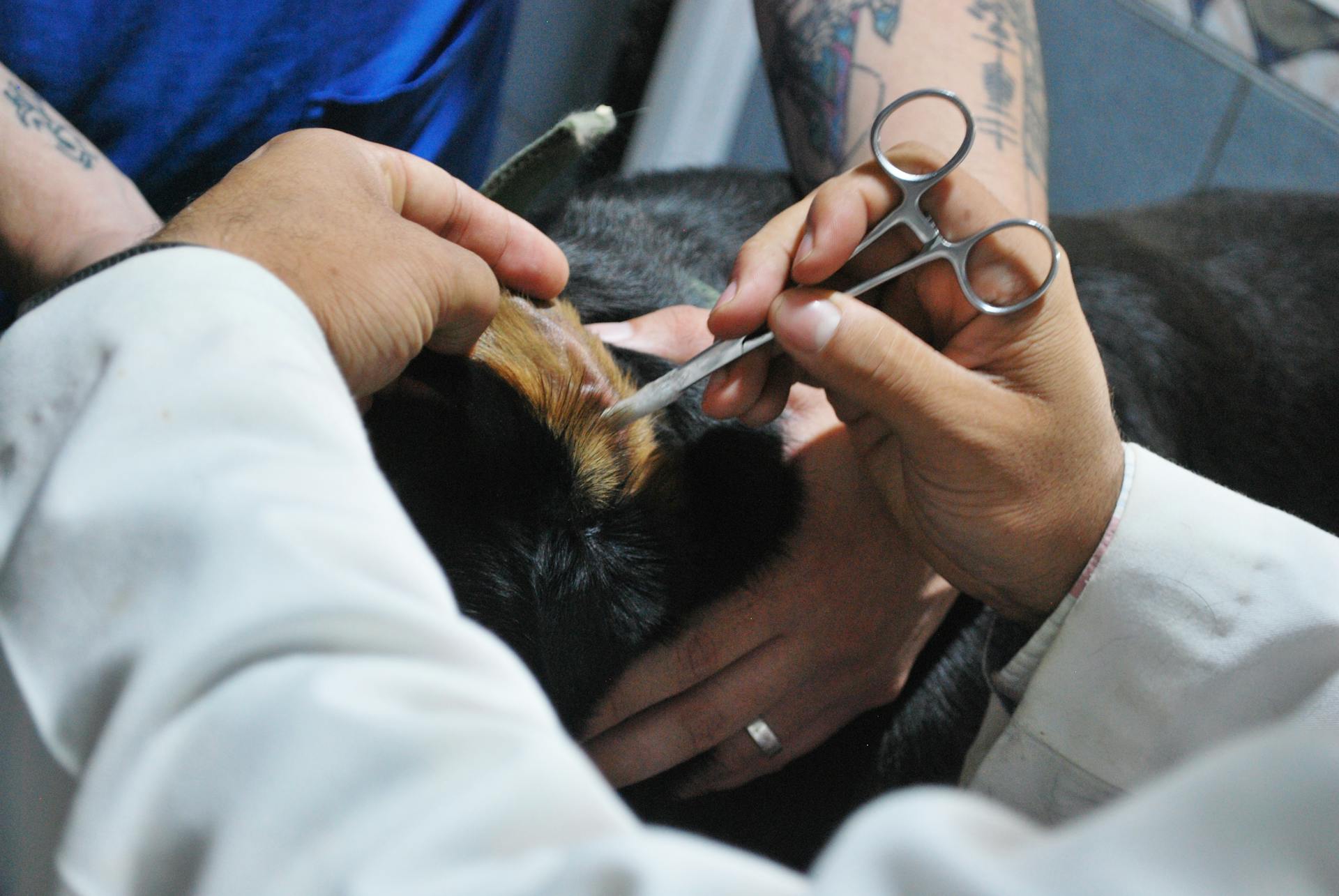
Ear cropping is a surgical procedure that's been a tradition in some dog breeds for centuries. The goal is to remove excess skin and tissue from a dog's ears to prevent infections and improve their appearance.
The procedure is usually performed on puppies between 6 to 12 weeks old, when they're still in the process of developing their ear cartilage. This is the ideal time for ear cropping, as it helps prevent future problems and ensures the ears heal properly.
Ear cropping can be done for both aesthetic and health reasons. Some breeds, like Doberman Pinschers and Boxers, are more prone to ear infections due to their floppy ears. By removing the excess skin, ear cropping helps reduce the risk of infections and keeps the ears clean.
Ear cropping is a relatively quick procedure that takes around 30 minutes to an hour to complete.
What Is Ear Cropping?
Ear cropping is a surgical procedure that involves altering the size and shape of a dog's ears to make them stand erect. It's a major surgery that requires anesthesia.
The procedure involves cutting and removing ear tissue, reshaping the ear cartilage, and suturing the area. This is done to encourage the ears to stand upright.
The ears are then taped and bandaged to help them heal in the desired shape. This process can be painful and requires careful aftercare to prevent complications.
Dog ear cropping is primarily done for aesthetic reasons, such as to meet breed standards in dog shows or competitions.
Why Do People Crop Dogs' Ears?
People crop dogs' ears for a variety of reasons, but most of these reasons are based on misconceptions. Some breeds, like the Miniature Pinscher and Brussels Griffon, had their ears cropped to minimize the risk of injury to the ear pinna when they were used as barn ratters.
Historically, many "bully breeds" were used for dog fighting, and their ears were severely cropped to prevent opponents from gaining an advantage. This closely cropped look has become synonymous with toughness, leading some breeders to crop the ears of all their puppies, regardless of whether they're intended for fighting or not.
Check this out: When Is It Too Late to Crop a Dog's Ears?
The idea that ear cropping improves a dog's hearing is another common misconception. In fact, there's no evidence to support this claim, and it's more likely that cropping actually decreases a dog's hearing acuity.
Most people in favor of ear-cropping base their opinions on these misconceptions, including the idea that it prevents ear infections, or that it's the breed standard. Here are some of the common justifications:
- “It prevents ear infections.”
- “It’s the breed standard.”
- “Tradition.”
- “It’s like ear piercing.”
- “It’s not painful.”
- “It helps dogs hear better.”
These justifications don't hold up to scrutiny, and ear cropping is often done for cosmetic reasons rather than any actual benefit to the dog.
Why Do People Crop Dogs' Ears?
People crop their dogs' ears for a variety of reasons, but most of these reasons have been proven false. Some breeds, like the Miniature Pinscher and Brussels Griffon, historically had their ears cropped to minimize the risk of injury to the ear pinna while barn rattering.
The look of closely cropped ears has become synonymous with toughness, an attribute admired by fans of bully breeds. This is a leftover from the inhumane dog fighting days, where fighting dogs had their ears severely cropped to prevent opponents from biting their sensitive pinna.
Take a look at this: Dogs Ears Cropped
Some breeders continue to crop the ears of these breeds to maintain the look related to their historic function. However, there's no evidence that ear cropping enhances a dog's hearing, and it may actually decrease their hearing acuity.
The most common reasons people give for ear cropping are misconceptions. Some claim it prevents ear infections, but a healthy diet and good grooming practices can achieve the same result without surgery. Others say it's the breed standard, but the AKC permits but doesn't require ear cropping.
Here are some of the most common misconceptions about ear cropping:
- “It prevents ear infections.”
- “It's the breed standard.”
- “Tradition.”
- “It's like ear piercing.”
- “It's not painful.”
- “It helps dogs hear better.”
Dog Cropping in Dog Shows
Dog cropping in dog shows is a topic of debate. The American Kennel Club (AKC) permits, but doesn't require, ear cropping in certain breed standards.
Some breeds, like the 20 recognized by the AKC, have cropped ears. The AKC formally protested the American Veterinary Medical Association's (AVMA) position statement against ear cropping and tail docking.
The AVMA, along with other veterinary associations, opposes ear cropping and tail docking for cosmetic purposes. They encourage breeders to eliminate these practices from breed standards.
The trend in dog shows is shifting towards accepting natural ears, prioritizing dogs' health and wellbeing.
Curious to learn more? Check out: Tail Docking Ear Cropping
The Procedure and Its Effects
Ear cropping is a surgical procedure that involves cutting, removing ear tissue, reshaping the ear cartilage, and suturing. It's done under anesthesia.
The ears are then taped and bandaged to encourage them to stand upright. This is a crucial part of the healing process, as it helps the ears heal in the desired position.
The recovery period can be uncomfortable, with dogs experiencing itchiness and showing signs of pain such as whimpering, restlessness, or lack of appetite. This requires careful aftercare to minimize the risk of infection and ensure proper healing.
The recovery period is usually 4 to 8 weeks, similar to the time it takes a person to heal from a broken arm.
Related reading: Ear Cropping Healing Process
How Are Dogs' Ears?
Dogs' ears are typically cropped when they're between 6 and 12 weeks old.
The procedure is usually done under general anesthesia by a veterinarian, who administers analgesia to minimize discomfort.
The ear pinna is very sensitive and contains many nerve endings, making it prone to pain even under anesthesia.
Puppies have their ears shaved and scrubbed with antibacterial soap before surgery.
The pinnas are then trimmed to the desired shape and size using a scalpel, surgical scissors, and/or a laser.
The cut edges are sutured and bandaged, and sometimes foam and glue are used to help "train" the newly cut ears to stand erect.
In some cases, the procedure is performed at home by a lay person, which can lead to high risks of infection and hemorrhage.
This is because the cleanliness standards of a surgical procedure are not adhered to, and the puppy is awake and often without any analgesics.
Regardless of who performs the ear cropping procedure, there is potential for post-operative complications, with infection and pain being the most common.
For your interest: Shih Tzu Ear Infection
Ear Cropping Procedure
Ear cropping is typically done when a puppy is between 6 and 12 weeks of age. The procedure is done under general anesthesia, and analgesia (pain medication) is administered to minimize discomfort during the procedure.
The ear pinna is very sensitive and contains many nerve endings, making it a sensitive area that requires careful handling. As a veterinarian, it's believed that postoperative pain management is necessary, but it's not always provided.
Some puppies have their ears cropped at home by a lay person, either a breeder or someone who claims proficiency in completing the procedure. However, this is often done without any analgesics, and the cleanliness standards of a surgical procedure are not adhered to.
The ear-cropping surgery is not the end of the procedure; most breeds require a significant amount of after-care to ensure that the cropped ears remain erect. This can last for several weeks or even months, depending on the breed and size of the dog.
Here's a brief overview of the ear cropping procedure:
- Shaving and scrubbing the puppy's ears with antibacterial soap
- Trimming the ear pinna to the desired shape and size
- Suturing and bandaging the cut edges
- Using foam and glue to help "train" the newly cut ears to stand erect
Regardless of who performs the ear cropping procedure, there is potential for post-operative complications, the most common being infection and pain.
Benefits and Alternatives
Ear cropping, while a common practice, may not be the best option for every dog. Some benefits of ear cropping include reduced risk of ear infections and improved hearing, but these benefits can be achieved through other means.
Ear infections are a major concern for many dog owners, and ear cropping can help reduce this risk. However, ear infections can also be prevented through regular ear cleaning and checking.
Improved hearing is another benefit of ear cropping, but it's not the only way to ensure your dog's ears are healthy. Regular ear checks can help identify potential issues before they become major problems.
In some breeds, ear cropping is a necessary step to prevent ear injuries. However, many breeds can thrive without ear cropping, and it's essential to consider the long-term health and well-being of your dog.
If you're considering ear cropping for your dog, you may want to consider alternative options, such as ear cleaning and regular check-ups. These alternatives can be just as effective in preventing ear infections and improving hearing.
Frequently Asked Questions
How long does it take for ear cropping to heal?
Healing time for ear cropping typically takes 14 days, but overall recovery can take 2 months or more, depending on the dog's size, age, and health
How painful is dog ear cropping?
Ear cropping can be an extremely painful procedure for dogs, especially if done without proper anaesthetic or pain relief. The level of pain can vary, but it's a serious consideration for dog owners.
How much does ear cropping normally cost?
Ear cropping typically costs between $150 and $600, with an average price of $250.
Sources
- https://www.picoriveravet.com/site/blog/2022/10/30/ear-cropping-dogs
- https://www.rspca.org.uk/adviceandwelfare/pets/dogs/health/earcropping
- http://www.primadobermans.com/ear-posting
- https://www.whole-dog-journal.com/health/ear-cropping/
- https://www.dogsnaturallymagazine.com/is-dog-ear-cropping-justified-today/
Featured Images: pexels.com

